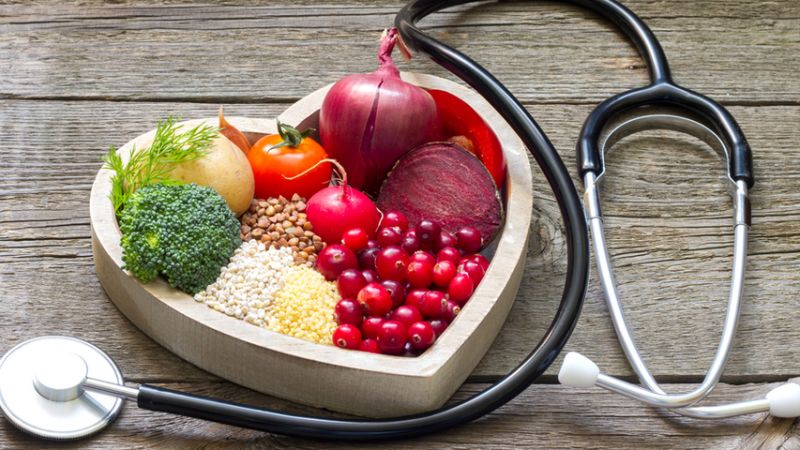February has been dedicated to American Heart Health Month, and for good reason. Cardiovascular disease is currently the leading cause of death in the United States—about 600,000 people die of heart disease every year. That’s a whopping 1 in every 4 deaths.
There are a variety of factors that increase your risk of developing heart disease, ranging from age, family history, and lifestyle choices. While you can’t really change your age or your genetics, you can make changes to your lifestyle—such as smoking cessation, participating in regular physical activity, and consuming a healthy diet—in order to greatly decrease your risk of heart disease.
Choosing heart-healthy foods is an integral part of taking preventative measures against heart disease. We asked Registered Dietician Robin Amylon for some heart-healthy diet tips to keep your heart beating strong as you age.
Understand How To Choose Heart-Healthy Foods
“I’d definitely recommend limiting your saturated fat intake,” says Amylon. “Saturated fat raises blood cholesterol and can lead to excess body fat. It is found predominantly in animal products such as fatty meat, poultry skin, bacon, sausage, whole milk, cream butter, ice cream, and cheese.”
Instead, she says, you can opt for more heart-healthy foods, such as skinless chicken breasts, lean cuts of meat, skim or 1% milk. She also recommends avoiding fried foods and choosing healthier options, like grilling, broiling, steaming, or baking.
“I also encourage my clients to limit their trans fat intake,” she says. “Trans fats are man-made and formed when unsaturated fats are hydrogenated—a process which changes liquid vegetable oils into a more solid fat product. Trans fats are the least healthy of all the types of fat! They not only increase LDL cholesterol levels (bad cholesterol) but they also decrease HDL cholesterol levels (good cholesterol).”
Trans fats also increase your risk of developing heart disease, type 2 diabetes, and cancer. They are primarily found in vegetable shortening, partially hydrogenated oil, deep fried foods, commercially baked goods, and most margarines. The best diet for heart disease is definitely one that eliminates trans fats.
“Food labels can sometimes be confusing,” Amylon says. “To see if a food item contains any trans fat look at the ingredients list for the words ‘partially hydrogenated.’ If any partially hydrogenated oils are listed in the ingredients, then the food product contains trans fat and you should stay away from it.”
Make Savvier Choices For A Heart-Healthy Diet
“A low sodium diet can help improve blood pressure and help prevent fluid accumulation in your body. It is recommended that you limit your salt intake to less than 2,000mg per day,” says Amylon.
In order to keep your sodium levels low and consume a heart-healthy diet, she suggests carefully reading the nutrition label for foods prior to purchase, and try to only choose foods that have no more than 140mg of sodium per serving. “Foods with more than 300mg of sodium per serving should be avoided at all costs!” she says.
As a frame of reference, Amylon has identified the following foods as being high in sodium:
-
Salt: a tsp of table salt has ~600mg sodium
-
Processed foods: salt is added in large amounts to help preserve foods to increase their shelf life
-
Canned products: soups, stews, gravy mixes, beans, and vegetables.
-
Snack foods: chips, crackers, popcorn, and salted pretzels
-
Frozen foods: dinners, entrees, vegetables with sauces
-
Packaged starchy foods: seasoned noodles or rice dishes, stuffing mix, macaroni and cheese
-
Meats and cheeses: deli or luncheon meats (bologna, ham, turkey, roast beef, etc.), cured or smoked meats, and all cheeses
-
Condiments, sauces, and seasonings: mustard, ketchup and salad dressing. Barbecue, pizza, chili, steak, soy or horseradish sauce. Any seasoning that has the word “salt” in the name or on the label. Season your foods with herbs and spices, pepper, vinegar, lemon or lime juice instead.
-
Pickles and olives
The best diet for heart disease also includes high fiber. “A diet high in soluble fiber can lower LDL cholesterol levels (bad cholesterol). An extra 5 to 10 grams of soluble fiber per day is associated with a 5% reduction in LDL cholesterol,” Amylon tells us. “Shoot for 20-30 grams of dietary fiber/day.”
This means adding more fruits, vegetables, whole grains, and dried beans to your daily menu. Aim for 5 cups of fruits and vegetables/day to get the benefits of these heart-healthy foods.
“My last tip for incorporating more heart-healthy foods is to eat more omega-3 fats,” Amylon tells us. “Omega-3 fats benefit health by increasing HDL cholesterol levels (good cholesterol) and lowering LDL cholesterol levels (bad cholesterol). This helps to reduce the risk of developing heart disease as well as other diseases.”
Good sources of omega-3 fats include salmon, tuna, mackerel, and sardines. She suggests that you should aim to eat fish at least twice a week to get the most out of your heart- healthy diet. Other good sources of omega-3 fats include walnuts, canola and soybean oil, and flaxseed.
Prevention Is More Than Just A Diet
When you are at risk for heart disease, it’s important to take the necessary preventative steps to avoid catastrophe later on. In addition to making changes to your diet and exercise routine, investing in a medical alert device could literally mean the difference between life and death should you experience heart failure. In fact, it’s been shown that every minute counts when a heart attack occurs, so making sure that you can remain connected to help at all times with a medical alert system from Medical Guardian is one of the best preventative measures you can take when it comes to heart disease.

